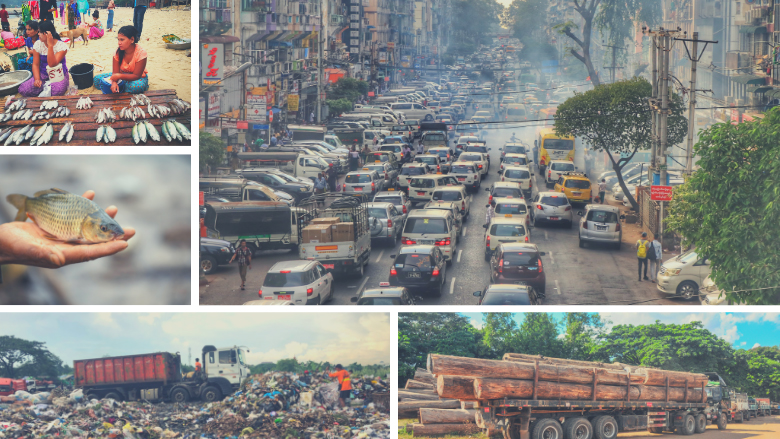Despite their critical role to the country’s development and economic transformation, Myanmar’s forestry, fisheries and the ecosystem they provide are under tremendous pressure. The Myanmar Country Environmental Analysis (CEA) draws on a comprehensive analysis on the country’s environment and natural resources challenges and identifies strategic recommendations to address the causes behind the degradation as well as to promote improved environmental management, investment and expenditure practices.
The situation
Between 1990 and 2015, the forest cover has been declining at an average rate of 1.2 percent a year, totaling around 10 million hectares. The overexploitation of fish stocks has contributed to a severe decline in Myanmar’s marine fish resources, reportedly by as much as 90 percent since 1979/80. The Myanmar Country Environmental Analysis sets out clear recommendations and actions for sustainable and inclusive development of the forestry and fisheries sectors, and the need for enhancing Environmental Impact Analysis systems, solid waste management and air pollution.
Myanmar has relied heavily on natural resource exploitation to sustain economic growth, and serious environmental issues are emerging, underlying the importance of transparent and robust Environmental Impact Assessment (EIA) system. Air quality is also increasingly compromised, as industrial and mining discharge, and urban waste bring new and increasing environmental health issues. Rapid urban growth in Myanmar generates additional pressures linked to solid waste generation.
The facts
On forestry:
The primary drivers of deforestation in Myanmar are land conversion (primarily for agriculture and mining), development of roads and other infrastructure, excessive and poor governance of the mining sector, increase in dams and reservoirs.
Some reports put wood fuel extraction as the biggest single demand on forest biomass, significantly greater than timber. Fuelwood is the primary fuel for as much as 95 percent of rural domestic energy needs, and estimations range between 60 to 80 percent of total energy consumption.
- Community Forestry has been hampered by limited capacity and financial resources of local Forest Department as well as local civil society staff related to awareness on CF rights and regulations.
On fisheries:
- Open-access and the ‘race to fish’ is the primary driver of depletion and overfishing in Myanmar.
- Large declines in numerous species of freshwater fish are reported throughout the Ayeyarwady River Basin, which covers around 60 percent of Myanmar’s land area.
- Illegal fishing in the inshore and offshore segments of Myanmar’s marine fisheries is commonplace and enforcement in many marine fisheries remain limited.
- The area of mangroves in Myanmar is the second largest in Southeast Asia after Indonesia, totaling around 500,000 hectares, but the rates of mangrove loss in this country are the highest in the region, with 2.2 percent annual over the period 2000-2012 or net loss of 191,120 hectares.
On the Environmental Impact Assessment system:
- The number of Environmental Impact Assessment/Initial Environment Examinations/Environmental Management Plans submitted is increasing every year. A high proportion of these reports is for the mining sector, which can be largely explained by the new licensing requirements for mining operations. while nearly all reports (89.6 percent) have been replied to, only a small fraction (6.9 percent) has been approved.
- Under the current system, it will not be possible to approve all of the outstanding EIAs. There is an urgent need to reform the EIA review process using a risk-based screening system for incoming reports.
- The Environmental Conservation Department currently does not have an effective and transparent mechanism for tracking the submission of EIA/IEE/EMP.
On solid waste management and pollution:
- Due to the current practice of open dumping of waste and the insufficient collection coverage and cleanliness, there are key environmental and operational issues as follows: landfills that are almost at their full capacity, waste dumping without any compaction, surface and groundwater contamination, methane production, release of greenhouse gas and potential landfill fires.
- In 2017, air pollution is estimated to have attributed to more than 45,000 deaths in Myanmar. As a risk factor for death, air pollution is higher in Myanmar than in other countries in the region and is almost twice the average for Southeast Asia. For Myanmar youth aged 5 to 14 years, particulate matter pollution is the leading risk factor of death among all risk factors, including malnutrition and other behavioral risks.
The recommendations
On forestry:
- Increased transparency, dialogue and social inclusion are some of the key elements of Myanmar’s forest reform process.
- Global experience shows that community forestry and smallholder plantations are financially and socially viable and can meaningfully contribute to rural income generation if the right incentives are in place.
- Wood processing can enhance exports and rural jobs creation.
On fisheries:
- Community-based fisheries management provides opportunities to promote more equitable distribution of benefits from inland and inshore fisheries, and for balancing competing demands between improving fisheries governance and safeguarding the livelihoods of the poor.
- International models for how certification, credit access and devolution of management powers can be used as tools to enhance the incentives for sustainable community-based fisheries.
- Improved fisheries governance and management offers significant opportunities to reduce local conflicts in coastal and floodplain areas.
On the Environmental Impact Assessment:
- The recommendations for improving the EIA system aims at ensuring that the government has a modernized information system for managing the EIA process, and that the Environmental Conservation Department is equipped with the appropriate technical capacity, tools, budget and resources to become a more effective environmental regulator.
On solid waste management and pollution:
- The roadmap for a plastic action plan is needed to analyze the negative economic impacts of plastic mismanagement.
- Establishing an ambient air quality monitoring network is needed to improve pollution control and management.
